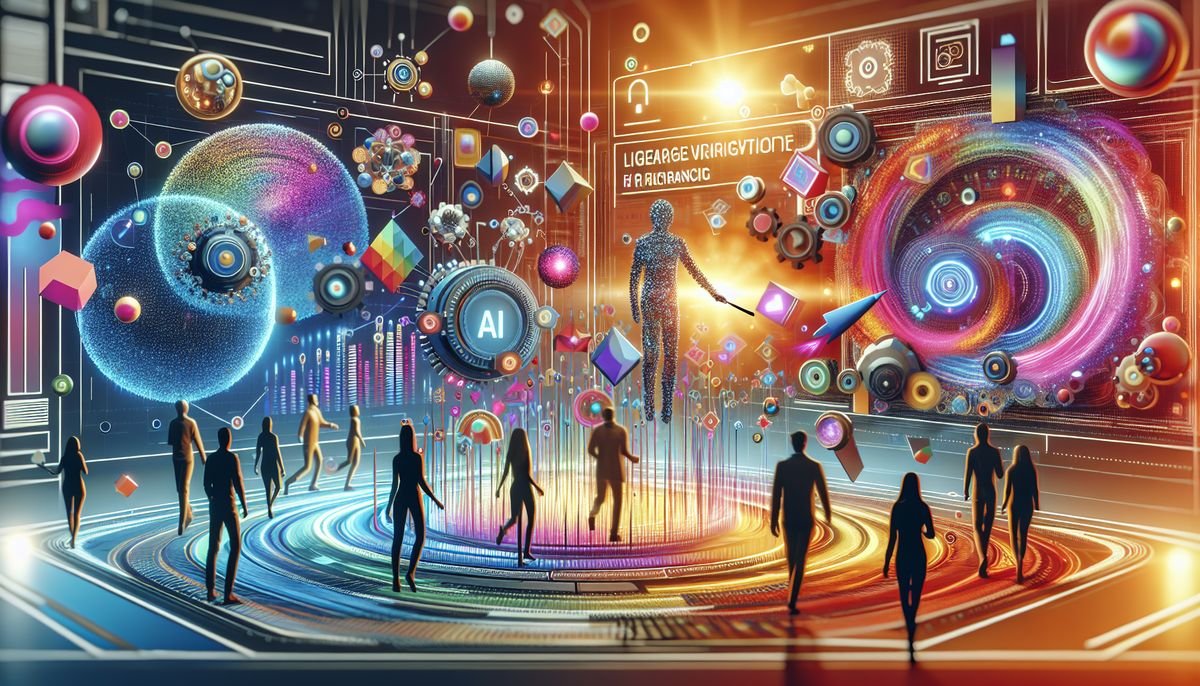In the rapidly evolving world of technology, businesses are continuously seeking innovative solutions to stay competitive. Generative AI has emerged as a transformative force in creative design, offering a myriad of applications that can enhance business operations. This guide explores how businesses can leverage Generative AI to unlock new levels of creativity and efficiency, providing a competitive edge in today’s dynamic market.
Key Takeaways
- Generative AI is revolutionizing business practices by offering new ways to automate processes, enhance creativity, and drive innovation across various industries.
- Implementing Generative AI requires a strategic approach, including understanding its capabilities, investing in team training, and establishing ethical guidelines.
- The future of Generative AI in business promises exciting advancements, with emerging trends likely to further transform business scalability and operational efficiency.
Best Practices for Leveraging Generative AI in Business
Understanding Generative AI Capabilities
Generative AI is at the forefront of a paradigm shift in creative design, enabling machines to generate content and mimic human-like thinking processes. This technology, often powered by large language models (LLMs), is not confined to rule-based outputs but can produce original and innovative work. Its applications span across industries, from graphic design to software development, and its potential for businesses is vast.
One of the most recent and notable applications of Generative AI is in the design industry, where it is used to create unique packaging and transform architectural planning. For instance, the technology has been employed to develop distinctive Nutella packaging, showcasing its ability to tailor designs to specific brand identities and consumer preferences.
Generative AI also inspires creativity in various fields, aiding in brainstorming and developing new ideas. It is redefining the boundaries of innovation, allowing for the creation of products and art that were previously unimaginable. As businesses look to harness the power of Generative AI, understanding its capabilities is the first step towards unlocking its full potential.
The transformative nature of Generative AI lies in its ability to not only enhance existing creative processes but also to automate and scale them, offering unprecedented efficiency and growth opportunities for businesses.
Investing in Team Training and Development
To fully harness the potential of generative AI, businesses must prioritize investing in team training and development. This investment goes beyond mere technical skills; it encompasses a comprehensive understanding of generative AI capabilities and ethical considerations. A well-trained team can innovate and adapt to the evolving landscape of AI technologies, ensuring that the business remains competitive and at the forefront of digital transformation.
One of the most effective ways to achieve this is through structured learning programs. For instance, Forbes recently highlighted The Best Generative AI Courses Money Can Buy, which offers a pathway for professionals to master generative AI. These courses cover a range of topics from basic principles to advanced techniques like prompt engineering, all tailored to enhance business applications.
It is essential for businesses to create a culture of continuous learning and improvement, where employees are encouraged to explore and utilize generative AI to drive business growth.
Furthermore, collaboration with AI development experts can provide valuable insights and accelerate the learning curve. Companies like TaskUs have demonstrated the importance of partnering with AI experts to create systems that not only streamline operations but also improve customer interactions. This synergy between human expertise and AI capabilities is a cornerstone for innovation and success in today’s market.
Ethical Considerations and Guidelines
In the realm of Generative AI, ethical considerations form the bedrock of sustainable and responsible technology deployment. Ensuring that deceptive AI conversations are actively mitigated and avoided helps foster trust between users and the technology. As Generative AI becomes more sophisticated, distinguishing between human and AI-generated content becomes increasingly challenging, raising concerns about deepfakes and misinformation. To combat this, businesses must establish clear guidelines and assign responsibility for any misuse of these powerful tools.
While ethical considerations are crucial, it is equally important to explore the possibilities and potential that generative AI holds for businesses. A balanced approach is necessary, where innovation is pursued without compromising ethical standards. This includes addressing issues such as bias in generated content and the need for extensive computing resources, which can pose challenges to ethical deployment.
By understanding and addressing these challenges, businesses can strategically integrate Generative AI into their operations, ensuring it complements human expertise and adheres to ethical norms.
To ensure ethical use and prevent misuse, businesses should consider the following steps:
- Establish a set of ethical guidelines specific to Generative AI applications.
- Implement regular audits to detect and correct biases in AI-generated content.
- Assign clear responsibility within the organization for overseeing AI ethics.
- Engage with stakeholders, including customers and regulatory bodies, to maintain transparency.
Collaboration with AI Development Experts
In the rapidly evolving landscape of generative AI, businesses are recognizing the value of partnering with AI development experts to harness the full potential of this technology. These collaborations are pivotal in navigating the complexities of AI integration and ensuring that the solutions are tailored to the unique needs of each business.
Recent discussions, such as those by Replit’s VP of Marketing and Design, David Hoang, highlight how AI is not only automating tasks but also bringing together design and development in unprecedented ways. By working with experts, businesses can leverage these insights to create more cohesive and innovative products.
The synergy between AI and human creativity is unlocking new possibilities in product design and development, fostering a culture of innovation that is essential for business growth.
Innovators in the field of business design are transforming organizations by closely collaborating with stakeholders. This approach allows them to identify opportunities where AI can provide significant value, addressing organizational challenges with precision and foresight.
Here are some steps to consider when collaborating with AI development experts:
- Identify clear objectives for AI integration
- Select AI development partners with a proven track record
- Establish a framework for ongoing communication and feedback
- Monitor AI-driven outcomes and adjust strategies accordingly
The Transformative Impact of Generative AI on Business Scaling
Success Stories from Diverse Industries
The integration of Generative AI across various sectors has led to a multitude of success stories that showcase its transformative power. In the manufacturing industry, for instance, Generative AI has revolutionized product design and quality control, leading to innovative solutions and enhanced efficiency.
- Retail Industry: Leveraging 3D product customization to offer unique customer experiences.
- Healthcare Industry: Utilizing AI for predictive diagnostics and personalized treatment plans.
- Automotive Industry: Implementing AR solutions for interactive customer engagement.
- Banking & Finance Industry: Advancing FinTech with secure, AI-driven online services.
The synergy between human creativity and Generative AI’s capabilities is crafting a new era of business innovation and customer satisfaction.
As businesses continue to explore the potential of Generative AI, they are finding new ways to scale operations, reduce costs, and create value for their customers. The stories of success are not just limited to large corporations; small and medium-sized enterprises are also harnessing the power of AI to compete in the global market.
Strategies for Implementing Generative AI
To harness the power of Generative AI, businesses must craft a strategic approach that aligns with their unique objectives and operational frameworks. A foundational strategy should encompass a clear understanding of Generative AI’s capabilities, a commitment to ongoing team education, and a robust ethical framework to guide its application.
- Assess Business Needs: Identify specific areas where Generative AI can enhance value.
- Define Clear Goals: Align Generative AI initiatives with overarching business objectives.
- Develop a Roadmap: Create a step-by-step plan for integration and scaling.
- Collaborate with Experts: Partner with AI developers and industry specialists.
By integrating Generative AI into business processes, companies can achieve a competitive edge, fostering innovation and driving growth.
It is crucial to stay informed about the latest trends and advancements in the field. For instance, recent discussions emphasize the importance of trusted Generative AI systems that prioritize compliance and security. This helps businesses not only to innovate but also to maintain integrity and trust with their stakeholders.
Quantifiable Benefits for Efficiency and Growth
The advent of generative AI has brought about a paradigm shift in how businesses approach efficiency and growth. Sophisticated algorithms have been instrumental in streamlining design and development processes, enabling companies to swiftly adapt to market changes and expedite product launches. This acceleration is not just about speed; it’s about the agility to innovate and the capacity to scale operations without proportional increases in costs or resources.
One of the most compelling advantages of generative AI is its impact on cost savings. By automating routine tasks and generating high-quality outputs, businesses can significantly reduce labor costs and minimize human error. The table below illustrates a simplified view of the potential cost savings across different departments within a company:
| Department | Traditional Cost | AI-Enhanced Cost | Savings |
|---|---|---|---|
| Marketing | $100,000 | $70,000 | $30,000 |
| R&D | $150,000 | $95,000 | $55,000 |
| IT | $120,000 | $80,000 | $40,000 |
The key to unlocking these benefits lies in the strategic implementation of generative AI, ensuring that it aligns with business objectives and complements human creativity and expertise.
As businesses continue to explore the capabilities of generative AI, they are finding that the technology not only enhances operational efficiency but also fosters an environment for continuous improvement and innovation. This is particularly evident in the realm of data analysis and business intelligence, where generative AI tools are enabling companies to derive actionable insights from vast amounts of data more quickly and accurately than ever before.
Emerging Trends and Future Outlook
As businesses continue to explore the potential of generative AI, one emerging trend is the integration of AI in hyperautomation strategies. Hyperautomation, a term coined to describe the extensive use of automation technologies to augment human capabilities, is being revolutionized by generative AI. By combining robotic process automation (RPA) with advanced AI algorithms, companies are not only automating routine tasks but also generating new insights and processes that were previously unattainable.
Another significant trend is the focus on personalized healthcare. Generative AI is poised to transform the medical industry by creating personalized treatment plans based on individual patient data. This could lead to a significant improvement in treatment outcomes, as the technology allows for a more nuanced understanding of patient needs.
In the realm of business intelligence, generative AI is becoming a pivotal tool. It is enhancing decision-making processes by providing deeper insights and foresight into market trends and consumer behavior.
Lastly, the demystification of AI technology is crucial for its adoption. As understanding grows, so does the trust in AI’s capabilities, leading to more innovative applications and a reduction in the fear surrounding the technology. Looking ahead, businesses that stay abreast of these trends and incorporate generative AI into their strategies will likely gain a competitive edge in their respective industries.
Embracing the Future with Generative AI
In conclusion, Generative AI is not just a fleeting trend but a transformative force reshaping the business landscape. As we have explored, its applications are diverse and its benefits, substantial—from streamlining operations and fostering innovation to scaling businesses and enhancing creative design. By adopting best practices, staying abreast of future trends, and learning from success stories, companies can leverage Generative AI to not only survive but thrive in an increasingly competitive market. The future belongs to those who are ready to embrace these advancements and turn them into opportunities for growth and differentiation.
Frequently Asked Questions
What are the best practices for leveraging Generative AI in business?
To maximize the benefits of Generative AI, businesses should thoroughly understand the technology and its capabilities, invest in continuous team training, regularly evaluate and refine ethical guidelines, and collaborate with experienced AI development experts.
How does Generative AI transform business scaling?
Generative AI streamlines workflows by automating repetitive tasks, leading to increased efficiency, faster processes, reduced time-to-market, and heightened productivity. It also contributes to cost reduction and enables businesses to allocate resources more strategically.
What are some future trends in Generative AI for business?
Future trends include the integration of Generative AI with technologies like blockchain and augmented reality, advancements in natural language processing, image generation, and new possibilities for creative applications and enhanced user experiences.



